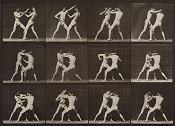
Eadweard Muybridge, Boxing; open-hand. Plate 340, 1887; collotype; Corcoran Gallery of Art, Washington, D.C.
From February 26 through June 7, 2011, the San Francisco Museum of Modern Art (SFMOMA) will showcase the first-ever retrospective examining all aspects of artist Eadweard Muybridge’s pioneering photography. Helios: Eadweard Muybridge in a Time of Change brings together more than 300 objects created between 1857 and 1893, including Muybridge’s only surviving zoopraxiscope—an apparatus he designed in 1879 to project motion pictures. Originally organized by Philip Brookman, Corcoran Gallery of Art chief curator and head of research, the San Francisco presentation is organized by SFMOMA Associate Curator of Photography Corey Keller.
Helios: Eadweard Muybridge in a Time of Change includes numerous vintage photographs, albums, stereographs, lantern slides, glass negatives and positives, patent models, zoopraxiscope discs, proof prints, notes, books, and other ephemera. The works have been brought together from 38 different collections and include a number of Muybridge’s photographs of Yosemite Valley, including dramatic waterfalls and mountain views from 1867 and 1872; images of Alaska and the Pacific coast; an 1869 survey of the Central Pacific and Union Pacific Railroads in California, Nevada, and Utah; pictures from the Modoc War, pictures from Panama and Guatemala; and urban panoramas of San Francisco. The exhibition also includes examples from Muybridge’s experimental series of sequential stop-motion photographs such as Attitudes of Animals in Motion (1881) and his later masterpiece Animal Locomotion (1887).
The exhibition is organized in a series of thematic sections that present the chronology of Muybridge’s career, the evolution of his unique sensibility, the foundations of his experimental approach to photography, and his connections to other people and events that helped guide his work. The sections include: Introduction: The Art of Eadweard Muybridge (1857–1887); The Infinite Landscape: Yosemite Valley and the Western Frontier (1867–1869); From California to the End of the Earth: San Francisco, Alaska, the Railroads, and the Pacific Coast (1868–1872); The Geology of Time: Yosemite and the High Sierra (1872); Stopping Time: California at the Crossroads of Perception (1872–1878); War, Murder, and the Production of Coffee: the Modoc War and the Development of Central America (1873–1875); Urban Panorama (1877–1880); The Horse in Motion (1877–1881); Motion Pictures: the Zoopraxiscope (1879–1893); and Animal Locomotion (1883–1893).
MUYBRIDGE AND SAN FRANCISCO
Best known for his groundbreaking studies of animals and humans in motion, Muybridge (1830–1904) was also an innovative and successful landscape and survey photographer, documentary artist, inventor, and war correspondent. Born in Kingston upon Thames, England, in 1830, Muybridge immigrated to the United States around 1851. He worked as a bookseller in New York and San Francisco and returned to London in 1860 following a serious injury. Muybridge learned photography in Britain and by 1867 returned to the United States, where began his career as a photographer in San Francisco. He gained recognition through innovative landscape photographs, which showed the grandeur and expansiveness of the American West. Between 1867 and 1871, these were published under the pseudonym “Helios.”
Muybridge spent most of his career in San Francisco and Philadelphia during a time of rapid industrial and technological growth. In the 1870s he developed new ways to stop motion with his camera. Muybridge’s legendary sequential photographs of running horses helped change how people saw the world. His projected animations inspired the early development of cinema, and his revolutionary techniques produced timeless images that have profoundly influenced generations of photographers, filmmakers, and visual artists.
Helios: Eadweard Muybridge in a Time of Change is organized by the Corcoran Gallery of Art, Washington, D.C. and made possible through the generous support of the Trellis Fund. Additional support is provided by the National Endowment for the Arts. The San Francisco presentation is made possible by generous support from Martha and Bruce Atwater and Nion T. McEvoy. Additional support provided by the George Frederick Jewett Foundation.
ABOUT THE CATALOGUE
The catalogue, Helios: Eadweard Muybridge in a Time of Change, includes essays by Marta Braun, Phillip Brookman, Corey Keller, Rebecca Solnit, and an introduction by Andy Grundberg. Published by Steidl, the book is available for purchase at the SFMOMA MuseumStore, or at sfmoma.org/museumstore, for $80.
ABOUT SFMOMA
SFMOMA welcomes more than 650,000 visitors annually and more than 46,000 students visit each year. Since opening its South of Market building in 1995, SFMOMA has added more than 13,000 works to its collections, 95 percent of which were donated, doubling its holdings to 26,000 works. At the same time, SFMOMA’s family programs have increased five-fold, teacher-training programs have increased six-fold, and gallery tours have expanded to 1,800. SFMOMA has mounted a series of exhibitions that have drawn both record attendance and critical praise, including recent exhibitions by Diane Arbus, Olafur Eliasson, Eva Hesse, Frida Kahlo, William Kentridge, Sol LeWitt, Richard Tuttle, and Jeff Wall.